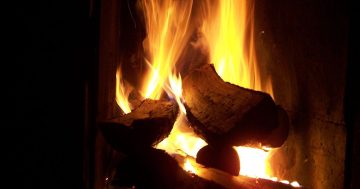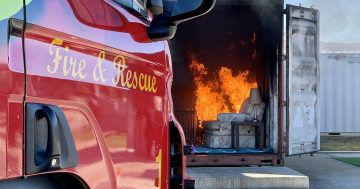
Smoke from woodfire heaters lingers longer in the Tuggeranong Valley. Photo: Clean Air Canberra.
The temperatures are dropping, and we’ve passed Anzac Day, which means many Canberrans are firing up their woodfire heaters to keep themselves toasty.
But what impact does this have on the Capital’s air quality, particularly for 12.1 per cent of Canberrans who live with asthma, and what’s the argument for woodfire heaters?
Asthma Australia CEO Michele Goldman said the smoke from wood heaters can be detrimental to many people in the community.
“People with asthma are among those most at risk of feeling unwell from breathing wood heater smoke, which is also harmful for pregnant people, infants and young children, the elderly and people with other chronic heart and lung conditions,” she said.
“That’s a lot of people living in our communities.”
An Asthma Australia report updated in April 2021 stated woodfire heater smoke is the largest source of winter air pollution in areas such as Canberra, Sydney and Tasmania.
From the survey, 14 per cent of people in the ACT reported using a woodfire heater as their main source of heating; however, they are responsible for two-thirds of PM10 emissions in Canberra. It is a common air pollutant, described by the Environment Protection Authority as very small particles found in dust and smoke that have a diameter of 10 micrometres (0.01mm) or smaller.
Ms Goldman said the smoke contains fine particulate matter, PM2.5, which is also found in bushfire smoke.
“There is no safe level of air pollution, which means even low levels of PM2.5 from wood heaters can cause serious health impacts,” she said.
However, with cost of living pressures and predicted increases to electricity prices, there is also a case for woodfire heaters over gas or ducted air-conditioning options.
Burning Log managing director Patrick Carey said the type of home you live in greatly impacted the effectiveness of your chosen method of heating.
“A lot of homes in Canberra were built in the 60s, 70s, 80s and 90s, and they don’t have the high energy ratings that newer builds do,” he said.
“To heat these types of homes effectively throughout the day, that’s where wood heaters come into their own.
“For some of these homes, wood heaters are really their only option; otherwise, the cost can be really prohibitive.
“Whereas some of these newer homes are very efficient, you can put in ducted air-conditioning and it’s fantastic.”
He said how people are using their woodfire heaters was changing as well, from a main source of heating to more ambient comfort.
“There’s a diversity in their use. For some people, they’re an occasional-type fire to light on a Friday or Saturday night during family time,” he said.
Older homes may not have the same insulation standards as modern builds, can have sealing issues around windows and doors, or don’t have double glazing that makes heating easier and more efficient.
Mr Carey also stressed that, as with any heating system, the way people used their wood heaters was incredibly important, as using them properly can help keep emissions down.
“At the moment, the standard is 1.5 grams of emissions per 1 kilogram, where going back 30 years ago, it was 10 to 15 times that,” he said.
“New fires are so much better [than they used to be]. They are so much more clean-burning and efficient.
“People shouldn’t just get caught up in the emissions rating because if you put that heater in the wrong situation, you’ll flip it. If you can’t warm your home as needed, the emissions and effectiveness will change.
“You’ve got to get a system that’s the right size for your house so you don’t have to burn more wood than you need.”
Mr Carey said following manufacturing guides was key to making sure you were using your fireplace in the most efficient way, and to emit the lowest emissions possible for that system.
“It comes with being a bit organised. Buy your wood early, go to a reputable wood yard, talk with the experts about where they get it from, and then store it properly to stay dry,” he said.
“Normally, these fires are most efficient when run on a low to medium setting, but you need to run them on high whenever you reload them with wood to get any moisture content out of the wood.”
The ACT Government’s Bushfire Smoke and Air Quality Strategy 2021-2025, published in November 2021, also highlighted the importance of people using their wood heaters correctly.
“The way wood heaters are designed in compliance with Australian Standards does not reflect how they are often operated in homes,” the report said.
“For example, they are often left overnight to smoulder, prompting inadequate burning, more emissions, and more significant climate impacts.”
Impacts were worse in areas such as the Tuggeranong Valley where the shape of the valley and temperature inversions held pollutants closer to the ground.
The ACT Government has a number of initiatives to address resident concerns over air quality and impacts from wood heaters.
“The Wood Heater Replacement Program offers rebates up to $1,250 for the removal and disposal of wood-burning heaters, or replacement with an efficient electric system,” an ACT Government spokesperson said.
“The ACT Government has placed a prohibition on wood heater installation in new development areas where planning studies show that they would adversely impact air quality.
“The ACT Government has taken this approach for the development of the Molonglo Valley (except Wright), and previously with the suburbs of Dunlop and East O’Malley.”
There is also the Burn Right Tonight campaign which outlines how Canberrans can use their wood heaters appropriately, as well as suggestions for heating alternatives.
In the most recent Air Quality Report (published June 2021), there were only 13 days where PM2.5 levels related to wood heater emissions in the Capital exceeded national emissions standards. These days occurred between mid-May to early August.
“A possible cause of this increase in PM2.5 may be due to people staying at home more during the COVID-19 pandemic,” the report stated.
“As a comparison, there were only two days in 2019 and one day in 2018 that exceeded national standards in winter months.”
The 2022 Air Quality Report will be published on 30 June 2022.

















